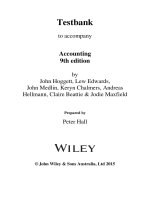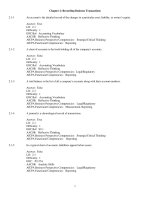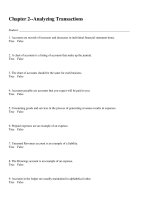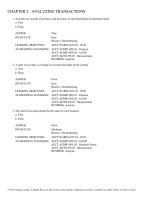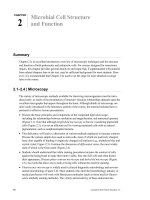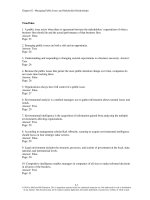Cost accounting 14th edition horngren test bank
Bạn đang xem bản rút gọn của tài liệu. Xem và tải ngay bản đầy đủ của tài liệu tại đây (190.85 KB, 68 trang )
Cost Accounting, 14e (Horngren/Datar/Rajan)
Chapter 2 An Introduction to Cost Terms and Purposes
Objective 2.1
1) Cost objects include:
A) products
B) customers
C) departments
D) All of these answers are correct.
Answer: D
Diff: 2
Terms: cost object
Objective: 1
AACSB: Reflective thinking
2) Actual costs are:
A) the costs incurred
B) budgeted costs
C) estimated costs
D) forecasted costs
Answer: A
Diff: 1
Terms: actual costing
Objective: 1
AACSB: Reflective thinking
3) The general term used to identify both the tracing and the allocation of accumulated costs to a cost
object is:
A) cost accumulation
B) cost assignment
C) cost tracing
D) conversion costing
Answer: B
Diff: 1
Terms: cost assignment
Objective: 1
AACSB: Reflective thinking
4) In order to make decisions, managers need to know:
A) actual costs
B) budgeted costs
C) both costs
D) neither cost
Answer: C
Diff: 1
Terms: budgeted costs
Objective: 1
AACSB: Ethical reasoning
1
Copyright © 2012 Pearson Education, Inc.
5) The collection of accounting data in some organized way is:
A) cost accumulation
B) cost assignment
C) cost tracing
D) conversion costing
Answer: A
Diff: 1
Terms: cost accumulation
Objective: 1
AACSB: Reflective thinking
6) Budgeted costs are:
A) the costs incurred this year
B) the costs incurred last year
C) planned or forecasted costs
D) competitor's costs
Answer: C
Diff: 2
Terms: budgeted costs
Objective: 1
AACSB: Reflective thinking
7) Cost assignment :
A) is always arbitrary
B) is includes tracing and allocating
C) is the same as cost accumulation
D) is finding the difference between budgeted and actual costs
Answer: B
Diff: 2
Terms: cost assignment
Objective: 1
AACSB: Reflective thinking
8) A cost system determines the cost of a cost object by:
A) accumulating and then assigning costs
B) accumulating costs
C) assigning and then accumulating costs
D) assigning costs
Answer: A
Diff: 2
Terms: cost accumulation
Objective: 1
AACSB: Reflective thinking
2
Copyright © 2012 Pearson Education, Inc.
9) Products, services, departments, and customers may be cost objects.
Answer: TRUE
Diff: 1
Terms: cost object
Objective: 1
AACSB: Reflective thinking
10) Costs are accounted for in two basic stages: assignment followed by accumulation.
Answer: FALSE
Explanation: Costs are accounted for in two basic stages: accumulation followed by assignment.
Diff: 1
Terms: cost accumulation
Objective: 1
AACSB: Reflective thinking
11) Actual costs and historical costs are two different terms referring to the same thing.
Answer: TRUE
Diff: 1
Terms: budgeted costs
Objective: 1
AACSB: Reflective thinking
12) Accountants define a cost as a resource to be sacrificed to achieve a specific objective.
Answer: TRUE
Diff: 1
Terms: cost
Objective: 1
AACSB: Reflective thinking
13) A cost object is always either a product or a service.
Answer: FALSE
Explanation: A cost object could be anything management wishes to determine the cost of, for example,
a department.
Diff: 2
Terms: cost object
Objective: 1
AACSB: Reflective thinking
14) A customer could be considered a cost object.
Answer: TRUE
Diff: 2
Terms: cost object
Objective: 1
AACSB: Analytical skills
3
Copyright © 2012 Pearson Education, Inc.
15) Lucas Manufacturing has three cost objects that it uses to accumulate costs for its manufacturing
plants. They are:
Cost object #1:
Cost object #2:
Cost object #3:
The physical buildings and equipment
The use of buildings and equipment
The availability and use of manufacturing labor
The following manufacturing overhead cost categories are found in the accounting records:
a. Depreciation on buildings and equipment
b. Lubricants for machines
c. Property insurance
d. Supervisors salaries
e. Fringe benefits
f. Property taxes
g. Utilities
Required:
Assign each of the above costs to the most appropriate cost object.
Answer:
Cost object # 1 includes categories a, c, and f.
Cost object # 2 includes categories b and g.
Cost object # 3 includes categories d and e.
Diff: 2
Terms: cost object
Objective: 1
AACSB: Analytical skills
Objective 2.2
1) Which of the following does NOT affect the direct/indirect classification of a cost?
A) the level of budgeted profit for the next year
B) the materiality of the cost in question
C) available technology to gather information about the cost
D) the design of the operation
Answer: A
Diff: 2
Terms: direct costs of a cost object, indirect costs of a cost object
Objective: 2
AACSB: Analytical skills
4
Copyright © 2012 Pearson Education, Inc.
2) Which of the following statements about the direct/indirect cost classification is NOT true?
A) Indirect costs are always traced.
B) Indirect costs are always allocated.
C) The design of operations affects the direct/indirect classification.
D) The direct/indirect classification depends on the choice of cost object.
Answer: A
Diff: 2
Terms: indirect manufacturing costs, cost allocation
Objective: 2
AACSB: Analytical skills
3) Cost tracing is:
A) the assignment of direct costs to the chosen cost object
B) a function of cost allocation
C) the process of tracking both direct and indirect costs associated with a cost object
D) the process of determining the actual cost of the cost object
Answer: A
Diff: 2
Terms: cost tracing
Objective: 2
AACSB: Reflective thinking
4) Cost allocation is:
A) the process of tracking both direct and indirect costs associated with a cost object
B) the process of determining the actual cost of the cost object
C) the assignment of indirect costs to the chosen cost object
D) a function of cost tracing
Answer: C
Diff: 2
Terms: cost allocation
Objective: 2
AACSB: Reflective thinking
5) The determination of a cost as either direct or indirect depends upon the:
A) accounting system
B) allocation system
C) cost tracing system
D) cost object chosen
Answer: D
Diff: 2
Terms: direct costs of a cost object, indirect costs of a cost object
Objective: 2
AACSB: Reflective thinking
5
Copyright © 2012 Pearson Education, Inc.
6) Classifying a cost as either direct or indirect depends upon:
A) the behavior of the cost in response to volume changes
B) whether the cost is expensed in the period in which it is incurred
C) whether the cost can be easily identified with the cost object
D) whether an expenditure is avoidable or not in the future
Answer: C
Diff: 2
Terms: direct costs of a cost object, indirect costs of a cost object
Objective: 2
AACSB: Reflective thinking
7) A manufacturing plant produces two product lines: golf equipment and soccer equipment. An
example of direct costs for the golf equipment line are:
A) beverages provided daily in the plant break room
B) monthly lease payments for a specialized piece of equipment needed to manufacture the golf driver
C) salaries of the clerical staff that work in the company administrative offices
D) utilities paid for the manufacturing plant
Answer: B
Diff: 2
Terms: direct costs of a cost object
Objective: 2
AACSB: Analytical skills
8) A manufacturing plant produces two product lines: golf equipment and soccer equipment. An
example of indirect cost for the soccer equipment line is:
A) material used to make the soccer balls
B) labor to shape the leather used to make the soccer ball
C) shift supervisor for the soccer line
D) plant supervisor
Answer: D
Diff: 2
Terms: indirect costs of a cost object
Objective: 2
AACSB: Analytical skills
9) Which one of the following items is a direct cost?
A) Customer-service costs of a multiproduct firm; Product A is the cost object.
B) Printing costs incurred for payroll check processing; payroll check processing is the cost object.
C) The salary of a maintenance supervisor in a multiproduct manufacturing plant; Product B is the cost
object.
D) Utility costs of the administrative offices; the accounting department is the cost object.
Answer: B
Diff: 2
Terms: direct costs of a cost object
Objective: 2
AACSB: Reflective thinking
6
Copyright © 2012 Pearson Education, Inc.
10) Indirect manufacturing costs:
A) can be traced to the product that created the costs
B) can be easily identified with the cost object
C) generally include the cost of material and the cost of labor
D) may include both variable and fixed costs
Answer: D
Diff: 2
Terms: indirect manufacturing costs
Objective: 2
AACSB: Reflective thinking
11) All of the following are true EXCEPT that indirect costs:
A) may be included in prime costs
B) are not easily traced to products or services
C) vary with the selection of the cost object
D) may be included in manufacturing overhead
Answer: A
Diff: 2
Terms: indirect manufacturing costs
Objective: 2
AACSB: Reflective thinking
12) Which statement is true?
A) All variable costs are direct costs.
B) Because of a cost-benefit tradeoff, some direct costs may be treated as indirect costs.
C) All fixed costs are indirect costs.
D) All direct costs are variable costs.
Answer: B
Diff: 3
Terms: variable costs, fixed costs, indirect costs of a cost object
Objective: 2
AACSB: Reflective thinking
13) Which statement is true?
A) A direct cost of one cost object cannot be an indirect cost of another cost object.
B) All variable costs are direct costs.
C) A direct cost of one cost object can be an indirect cost of another cost object.
D) All fixed costs are direct costs.
Answer: C
Diff: 3
Terms: direct costs, indirect costs
Objective: 2
AACSB: Reflective thinking
7
Copyright © 2012 Pearson Education, Inc.
14) The same cost may be direct for one cost object and indirect for another cost object.
Answer: TRUE
Diff: 3
Terms: cost object
Objective: 2
AACSB: Analytical skills
15) Assigning direct costs poses more problems than assigning indirect costs.
Answer: FALSE
Explanation: Tracing direct costs is quite straightforward, whereas assigning indirect costs to a number
of different cost objects can be very challenging.
Diff: 2
Terms: direct costs of a cost object, indirect costs of a cost object
Objective: 2
AACSB: Analytical skills
16) Improvements in information-gathering technologies are making it possible to trace more costs as
direct.
Answer: TRUE
Diff: 2
Terms: direct costs of a cost object
Objective: 2
AACSB: Use of Information Technology
17) Misallocated indirect costs may lead to NOT promoting profitability.
Answer: TRUE
Diff: 2
Terms: cost allocation
Objective: 2
AACSB: Analytical skills
18) The materiality of the cost is a factor in classifying the cost as a direct or indirect cost.
Answer: TRUE
Diff: 2
Terms: direct costs of a cost object, indirect costs of a cost object
Objective: 2
AACSB: Reflective thinking
19) The cost of electricity used in the production of multiple products would be classified as a indirect
cost.
Answer: TRUE
Diff: 1
Terms: direct costs of a cost object
Objective: 2
AACSB: Analytical skills
8
Copyright © 2012 Pearson Education, Inc.
20) Some fixed costs may be classified as direct manufacturing costs.
Answer: TRUE
Diff: 1
Terms: fixed costs, direct costs of a cost object
Objective: 2
AACSB: Analytical skills
21) The distinction between direct and indirect costs is clearly set forth in Generally Accepted
Accounting Principles (GAAP).
Answer: FALSE
Explanation: The distinction between direct and indirect costs is not set forth in GAAP. Direct costs of
a cost object are related to the particular cost object and can be traced to it in an economically feasible
(cost-effective) way. Indirect costs of a cost object are related to the particular cost object but cannot be
traced to it in an economically feasible (cost-effective) way.
Diff: 2
Terms: direct costs of a cost object, indirect costs of a cost object
Objective: 2
AACSB: Reflective thinking
22) Archambeau Products Company manufactures office furniture. Recently, the company decided to
develop a formal cost accounting system and classify all costs into three categories. Categorize each of
the following items as being appropriate for (1) cost tracing to the finished furniture, (2) cost allocation
of an indirect manufacturing cost to the finished furniture, or (3) as a nonmanufacturing item.
Item
Cost
Tracing
Carpenter wages
Depreciation - office building
Glue for assembly
Lathe department supervisor
Lathe depreciation
Lathe maintenance
Lathe operator wages
Lumber
Samples for trade shows
Metal brackets for drawers
Factory washroom supplies
________
________
________
________
________
________
________
________
________
________
________
Cost
Allocation
________
________
________
________
________
________
________
________
________
________
________
Nonmanufacturing
________
________
________
________
________
________
________
________
________
________
________
9
Copyright © 2012 Pearson Education, Inc.
Answer:
Item
Cost
Tracing
Carpenter wages
Depreciation - office building
Glue for assembly
Lathe department supervisor
Lathe depreciation
Lathe maintenance
Lathe operator wages
Lumber
Samples for trade shows
Metal brackets for drawers
Factory washroom supplies
Diff: 2
Terms: cost tracing, cost allocation
Objective: 2
AACSB: Analytical skills
Cost
Allocation
Nonmanufacturing
X
X
X
X
X
X
X
X
X
X
X
23) Why is it possible that a raw material such as glue might be considered as an indirect material for
one furniture manufacturer and as a direct material for another furniture manufacture?
Answer: It is possible for a raw material such as glue to be considered as an indirect material by one
furniture manufacturer and as a direct material by another furniture manufacturer. The decision is
largely a choice by the manufacturer and depends on a number of factors including the materiality of the
cost in question, the cost of gathering the information, and the design of the manufacturing process. If
the product in question has an insignificant cost, it might not be worth the trouble to trace the cost of the
glue to each piece of furniture, and the glue would be considered indirect. If the cost of tracing the cost
of the glue is high in relation to the benefits received from tracing it, the glue would likely be considered
as indirect material. If the design of the manufacturing process easily permits all the glue to be traced to
a single type of furniture, then it would be easy for a company to consider that material to be direct.
Overall, the direct/indirect classification is decided on a cost/benefit basis.
Diff: 3
Terms: direct material
Objective: 2
AACSB: Reflective thinking
24) What are the differences between direct costs and indirect costs? Give an example of each.
Answer: Direct costs are costs that can be traced easily to the product manufactured or the service
rendered. Examples of direct costs include direct materials and direct manufacturing labor used in a
product. Indirect costs cannot be easily identified with individual products or services rendered, and are
usually assigned using allocation formulas. In a plant that manufactures multiple products, examples of
indirect costs include the plant supervisor's salary and the cost of machines used to produce more than
one type of product.
Diff: 2
Terms: direct costs, indirect costs
Objective: 2
AACSB: Reflective thinking
10
Copyright © 2012 Pearson Education, Inc.
Objective 2.3
1) A mixed cost is:
A) a fixed cost
B) a cost with fixed and variable elements
C) a variable cost
D) always an indirect cost
Answer: B
Diff: 2
Terms: mixed cost
Objective: 3
AACSB: Reflective thinking
2) Which of the following is a mixed cost?
A) monthly rent payment
B) manager's salary
C) monthly electric bill
D) direct materials
Answer: C
Diff: 2
Terms: mixed cost
Objective: 3
AACSB: Analytical skills
3) Cost behavior refers to:
A) how costs react to a change in the level of activity
B) whether a cost is incurred in a manufacturing, merchandising, or service company
C) classifying costs as either inventoriable or period costs
D) whether a particular expense has been ethically incurred
Answer: A
Diff: 2
Terms: fixed cost, variable cost
Objective: 3
AACSB: Reflective thinking
4) An understanding of the underlying behavior of costs helps in all of the following EXCEPT:
A) costs can be better estimated as volume expands and contracts
B) true costs can be better evaluated
C) process inefficiencies can be better identified and as a result improved
D) sales volume can be better estimated
Answer: D
Diff: 2
Terms: fixed cost, variable cost
Objective: 3
AACSB: Analytical skills
11
Copyright © 2012 Pearson Education, Inc.
5) At a plant where a union agreement sets annual salaries and conditions, annual labor costs usually:
A) are considered a variable cost
B) are considered a fixed cost
C) depend on the scheduling of floor workers
D) depend on the scheduling of production runs
Answer: B
Diff: 2
Terms: fixed cost
Objective: 3
AACSB: Reflective thinking
6) Variable costs:
A) are always indirect costs
B) increase in total when the actual level of activity increases
C) include most personnel costs and depreciation on machinery
D) can always be traced directly to the cost object
Answer: B
Diff: 2
Terms: variable cost
Objective: 3
AACSB: Reflective thinking
7) Fixed costs:
A) may include either direct or indirect costs
B) vary with production or sales volumes
C) include parts and materials used to manufacture a product
D) can be adjusted in the short run to meet actual demands
Answer: A
Diff: 2
Terms: fixed cost
Objective: 3
AACSB: Reflective thinking
8) Fixed costs depend on the:
A) amount of resources used
B) amount of resources acquired
C) volume of production
D) volume of sales
Answer: B
Diff: 3
Terms: fixed cost
Objective: 3
AACSB: Reflective thinking
12
Copyright © 2012 Pearson Education, Inc.
9) Which one of the following is a variable cost for an insurance company?
A) rent
B) president's salary
C) sales commissions
D) property taxes
Answer: C
Diff: 1
Terms: variable cost
Objective: 3
AACSB: Analytical skills
10) Which of the following is a fixed cost for an automobile manufacturing plant?
A) administrative salaries
B) electricity used by assembly-line machines
C) sales commissions
D) windows for each car produced
Answer: A
Diff: 2
Terms: fixed cost
Objective: 3
AACSB: Analytical skills
11) If each motorcycle requires a belt that costs $20 and 2,000 motorcycles are produced for the month,
the total cost for belts is:
A) considered to be a direct fixed cost
B) considered to be a direct variable cost
C) considered to be an indirect fixed cost
D) considered to be an indirect variable cost
Answer: B
Diff: 3
Terms: direct costs of a cost object, variable cost
Objective: 3
AACSB: Analytical skills
12) The most likely cost driver of distribution costs is the:
A) number of parts within the product
B) number of miles driven
C) number of products manufactured
D) number of production hours
Answer: B
Diff: 2
Terms: cost driver
Objective: 3
AACSB: Analytical skills
13
Copyright © 2012 Pearson Education, Inc.
13) The most likely cost driver of direct labor costs is the:
A) number of machine setups for the product
B) number of miles driven
C) number of production hours
D) number of machine hours
Answer: C
Diff: 2
Terms: cost driver
Objective: 3
AACSB: Analytical skills
14) Which of the following statements is FALSE?
A) There is a cause-and-effect relationship between the cost driver and the amount of cost.
B) Fixed costs have cost drivers over the short run.
C) Over the long run all costs have cost drivers.
D) Volume of production is a cost driver of direct manufacturing costs.
Answer: B
Diff: 2
Terms: cost driver
Objective: 3
AACSB: Reflective thinking
15) A band of normal activity or volume in which specific cost-volume relationships are maintained is
referred to as the:
A) average range
B) cost-allocation range
C) cost driver range
D) relevant range
Answer: D
Diff: 1
Terms: relevant range
Objective: 3
AACSB: Reflective thinking
16) Within the relevant range, if there is a change in the level of the cost driver, then:
A) total fixed costs and total variable costs will change
B) total fixed costs and total variable costs will remain the same
C) total fixed costs will remain the same and total variable costs will change
D) total fixed costs will change and total variable costs will remain the same
Answer: C
Diff: 2
Terms: fixed cost, variable cost
Objective: 3
AACSB: Reflective thinking
14
Copyright © 2012 Pearson Education, Inc.
17) Within the relevant range, if there is a change in the level of the cost driver, then:
A) fixed and variable costs per unit will change
B) fixed and variable costs per unit will remain the same
C) fixed costs per unit will remain the same and variable costs per unit will change
D) fixed costs per unit will change and variable costs per unit will remain the same
Answer: D
Diff: 2
Terms: relevant range
Objective: 3
AACSB: Reflective thinking
18) Which of the following would be LEAST likely to be a cost driver for a company's human resource
costs?
A) the number of employees in the human resource department
B) the number of job applications processed
C) the number of units sold
D) the square footage of the office space used by the human resource department
Answer: C
Diff: 2
Terms: cost driver
Objective: 3
AACSB: Analytical skills
Answer the following questions using the information below:
The Singer Company manufactures several different products. Unit costs associated with Product
ICT101 are as follows:
Direct materials
$ 60
Direct manufacturing labor
10
Variable manufacturing overhead
18
Fixed manufacturing overhead
32
Sales commissions (2% of sales)
4
Administrative salaries
16
Total
$140
19) What are the variable costs per unit associated with Product ICT101?
A) $18
B) $22
C) $88
D) $92
Answer: D
Explanation: D) $60 + $10 + $18 + $4 = $92
Diff: 2
Terms: variable cost
Objective: 3
AACSB: Analytical skills
15
Copyright © 2012 Pearson Education, Inc.
20) What are the fixed costs per unit associated with Product ICT101?
A) $102
B) $48
C) $52
D) $32
Answer: B
Explanation: B) $32 + 16 = $48
Diff: 2
Terms: fixed cost
Objective: 3
AACSB: Analytical skills
Answer the following questions using the information below:
The East Company manufactures several different products. Unit costs associated with Product ORD203
are as follows:
Direct materials
$50
Direct manufacturing labor
8
Variable manufacturing overhead
10
Fixed manufacturing overhead
23
Sales commissions (2% of sales)
5
Administrative salaries
9
Total
$105
21) What are the variable costs per unit associated with Product ORD203?
A) $60
B) $82
C) $73
D) $105
Answer: C
Explanation: C) $50 + $8 + $10 + $5 = $73
Diff: 2
Terms: variable cost
Objective: 3
AACSB: Analytical skills
22) What are the fixed costs per unit associated with Product ORD203?
A) $23
B) $32
C) $35
D) $44
Answer: B
Explanation: B) $23 + 9 = $32
Diff: 2
Terms: fixed cost
Objective: 3
AACSB: Analytical skills
16
Copyright © 2012 Pearson Education, Inc.
23) Fixed costs in total will NOT change in the short run, but may change in the long run.
Answer: TRUE
Diff: 2
Terms: fixed cost
Objective: 3
AACSB: Reflective thinking
24) Costs that are difficult to change over the short run are always variable over the long run.
Answer: TRUE
Diff: 2
Terms: variable cost
Objective: 3
AACSB: Analytical skills
25) A decision maker CANNOT adjust capacity over the short run.
Answer: TRUE
Diff: 1
Terms: fixed cost
Objective: 3
AACSB: Analytical skills
26) Variable costs per unit vary with the level of production or sales volume.
Answer: FALSE
Explanation: Variable costs per unit are constant with the level of production or sales volume.
Diff: 1
Terms: variable cost
Objective: 3
AACSB: Reflective thinking
27) Currently, most administrative personnel costs would be classified as fixed costs.
Answer: TRUE
Diff: 1
Terms: fixed cost
Objective: 3
AACSB: Reflective thinking
28) Fixed costs depend on the resources used, not the resources acquired.
Answer: FALSE
Explanation: Fixed costs depend on the resources acquired, and not whether the resources are used or
not.
Diff: 2
Terms: fixed cost
Objective: 3
AACSB: Reflective thinking
17
Copyright © 2012 Pearson Education, Inc.
29) The variable cost per unit of a product should stay the same throughout the relevant range of
production.
Answer: TRUE
Diff: 2
Terms: variable cost, relevant range
Objective: 3
AACSB: Reflective thinking
30) An appropriate cost driver for shipping costs might be the number of units shipped.
Answer: TRUE
Diff: 2
Terms: cost driver
Objective: 3
AACSB: Analytical skills
31) Butler Hospital wants to estimate the cost for each patient stay. It is a general health care facility
offering only basic services and not specialized services such as organ transplants.
Required:
a. Classify each of the following costs as either direct or indirect with respect to each patient.
b. Classify each of the following costs as either fixed or variable with respect to hospital costs per day.
Direct
Indirect
Electronic monitoring
Meals for patients
Nurses' salaries
Parking maintenance
Security
________
________
________
________
________
________
________
________
________
________
Answer:
Direct
Indirect
Fixed
________
________
________
________
________
Fixed
Variable
________
________
________
________
________
Variable
Electronic monitoring
X
X
Meals for patients
X
X
Nurses' salaries
X
X
Parking maintenance
X
X
Security
X
X
Diff: 2
Terms: direct costs, indirect costs, fixed costs, variable costs
Objective: 2, 3
AACSB: Analytical skills
18
Copyright © 2012 Pearson Education, Inc.
32) The list of representative cost drivers in the right column below are randomized with respect to the
list of functions in the left column. That is, they do not match.
1.
2.
3.
4.
5.
6.
Function
Purchasing
Billing
Shipping
Computer Support
Personnel
Customer Service
A.
B.
C.
D.
E.
F.
Representative Cost Driver
Number of employees
Number of shipments
Number of customers
Number of invoices
Number of desktop computers
Number of purchase orders
Required:
Match each business function with its representative cost driver.
1.
2.
3.
4.
5.
6.
Function
Purchasing
Billing
Shipping
Computer Support
Personnel
Customer Service
Insert letter of appropriate driver (A through F)
Answer:
1.
2.
3.
4.
5.
6.
Function
Purchasing
Billing
Shipping
Computer Support
Personnel
Customer Service
Insert letter of appropriate driver (A through F)
F
D
B
E
A
C
Diff: 2
Terms: cost driver
Objective: 3
AACSB: Analytical skills
33) Describe a variable cost. Describe a fixed cost. Explain why the distinction between variable and
fixed costs is important in cost accounting.
Answer: Total variable costs increase with increased production or sales volumes.
Fixed costs are not influenced by fluctuations in production or sales volumes.
Without the knowledge of cost behaviors, budgets and other forecasting tools will be inaccurate and
unreliable. Understanding whether a cost behaves as a variable or a fixed cost is essential to estimating
and planning for business success.
Diff: 2
Terms: variable cost, fixed cost
Objective: 3
AACSB: Reflective thinking
19
Copyright © 2012 Pearson Education, Inc.
Objective 2.4
1) A unit cost is computed by:
A) multiplying total cost by the number of units
B) dividing total cost by the number of units
C) dividing variable cost by the number of units
D) adding variable cost to fixed cost
Answer: B
Diff: 2
Terms: unit cost
Objective: 4
AACSB: Reflective thinking
2) In making product mix and pricing decisions, managers should focus on:
A) total costs
B) unit costs
C) variable costs
D) fixed costs
Answer: A
Diff: 2
Terms: total cost
Objective: 4
AACSB: Ethical reasoning
3) When 20,000 units are produced, fixed costs are $16 per unit. Therefore, when 40,000 units are
produced fixed costs will:
A) increase to $32 per unit
B) remain at $16 per unit
C) decrease to $8 per unit
D) total $640,000
Answer: C
Diff: 3
Terms: fixed cost
Objective: 4
AACSB: Analytical skills
4) When 10,000 units are produced, variable costs are $6 per unit. Therefore, when 20,000 units are
produced:
A) variable costs will total $120,000
B) variable costs will total $60,000
C) variable unit costs will increase to $12 per unit
D) variable unit costs will decrease to $3 per unit
Answer: A
Diff: 3
Terms: variable cost
Objective: 4
AACSB: Analytical skills
20
Copyright © 2012 Pearson Education, Inc.
5) Amber Manufacturing provided the following information for last month:
Sales
Variable costs
Fixed costs
Operating income
$20,000
6,000
9,000
$5,000
If sales double next month, what is the projected operating income?
A) $10,000
B) $25,000
C) $19,000
D) $12,000
Answer: C
Explanation: C) ($20,000 × 2) - ($6,000 × 2) - $9,000 = $19,000
Diff: 3
Terms: fixed cost, variable cost
Objective: 4
AACSB: Analytical skills
6) Kym Manufacturing provided the following information for last month:
Sales
Variable costs
Fixed costs
Operating income
$12,000
4,000
1,000
$7,000
If sales double next month, what is the projected operating income?
A) $14,000
B) $15,000
C) $18,000
D) $19,000
Answer: B
Explanation: B) ($12,000 × 2) - ($4,000 × 2) - $1,000 = $15,000
Diff: 3
Terms: fixed cost, variable cost
Objective: 4
AACSB: Analytical skills
21
Copyright © 2012 Pearson Education, Inc.
7) Wheel and Tire Manufacturing currently produces 1,000 tires per month. The following per unit data
apply for sales to regular customers:
Direct materials
$20
Direct manufacturing labor
3
Variable manufacturing overhead 6
Fixed manufacturing overhead
10
Total manufacturing costs
$39
The plant has capacity for 3,000 tires and is considering expanding production to 2,000 tires. What is the
total cost of producing 2,000 tires?
A) $39,000
B) $78,000
C) $68,000
D) $62,000
Answer: C
Explanation: C) [($20 + $3 + $6) × 2,000 units] + ($10 × 1,000 units) = $68,000
Diff: 2
Terms: fixed cost, variable cost
Objective: 4
AACSB: Analytical skills
8) XIAN Manufacturing produces a unique valve, and has the capacity to produce 50,000 valves
annually. Currently XIAN produces 40,000 valves and is thinking about increasing production to 45,000
valves next year. What is the most likely behavior of total manufacturing costs and unit manufacturing
costs given this change?
A) Total manufacturing costs will increase and unit manufacturing costs will stay the same.
B) Total manufacturing costs will increase and unit manufacturing costs will decrease.
C) Total manufacturing costs will stay the same and unit manufacturing costs will stay the same.
D) Total manufacturing costs will stay the same and unit manufacturing costs will decrease.
Answer: B
Diff: 3
Terms: fixed cost, variable cost
Objective: 4
AACSB: Analytical skills
22
Copyright © 2012 Pearson Education, Inc.
9) Tire and Spoke Manufacturing currently produces 1,000 bicycles per month. The following per unit
data apply for sales to regular customers:
Direct materials
$50
Direct manufacturing labor
5
Variable manufacturing overhead 14
Fixed manufacturing overhead
10
Total manufacturing costs $79
The plant has capacity for 3,000 bicycles and is considering expanding production to 2,000 bicycles.
What is the per unit cost of producing 2,000 bicycles?
A) $79 per unit
B) $158 per unit
C) $74 per unit
D) $134 per unit
Answer: C
Explanation: C) [($50 + $5 + $14) × 2,000 units] + ($10 × 1,000 units) = $148,000 / 2,000 units = $74
Diff: 3
Terms: unit cost
Objective: 4
AACSB: Analytical skills
Answer the following questions using the information below:
Axle and Wheel Manufacturing currently produces 1,000 axles per month. The following per unit data
apply for sales to regular customers:
Direct materials
Direct manufacturing labor
Variable manufacturing overhead
Fixed manufacturing overhead
Total manufacturing costs
$30
5
10
40
$85
10) The plant has capacity for 3,000 axles and is considering expanding production to 3,000 axles. What
is the total cost of producing 3,000 axles?
A) $135,000
B) $225,000
C) $175,000
D) $255,000
Answer: C
Explanation: C) [($30 + $5 + $10) × 3,000 units] + ($40 × 1,000 units) = $175,000
Diff: 2
Terms: fixed cost, variable cost
Objective: 4
AACSB: Analytical skills
23
Copyright © 2012 Pearson Education, Inc.
11) What is the per unit cost when producing 3,000 axles?
A) $58.33
B) $175.00
C) $85.00
D) $125.00
Answer: A
Explanation: A) $175,000 / 3,000 = $58.33
Diff: 2
Terms: unit cost
Objective: 4
AACSB: Analytical skills
Answer the following questions using the information below:
Pederson Company reported the following:
Manufacturing costs
Units manufactured
Units sold
Beginning inventory
$2,000,000
50,000
47,000 units sold for $75 per unit
0 units
12) What is the average manufacturing cost per unit?
A) $40.00
B) $42.55
C) $0.025
D) $75.00
Answer: A
Explanation: A) $2,000,000 / 50,000 = $40.00
Diff: 1
Terms: average cost, unit cost
Objective: 4
AACSB: Analytical skills
13) What is the amount of ending finished goods inventory?
A) $1,880,000
B) $120,000
C) $225,000
D) $105,000
Answer: B
Explanation: B) (50,000 - 47,000) × ($2,000,000 / $50,000) = $120,000
Diff: 2
Terms: finished-goods inventory
Objective: 4
AACSB: Analytical skills
24
Copyright © 2012 Pearson Education, Inc.
Answer the following questions using the information below:
The following information pertains to Alleigh's Mannequins:
Manufacturing costs
Units manufactured
Units sold
Beginning inventory
$1,500,000
30,000
29,500 units sold for $85 per unit
0 units
14) What is the average manufacturing cost per unit?
A) $50.00
B) $50.85
C) $17.65
D) $85.00
Answer: A
Explanation: A) $1,500,000 / 30,000 = $50.00
Diff: 1
Terms: unit cost
Objective: 4
AACSB: Analytical skills
15) What is the amount of ending finished goods inventory?
A) $42,500
B) $25,424
C) $25,000
D) $1,475,000
Answer: C
Explanation: C) (30,000 - 29,500) × ($1,500,000 / $30,000) = $25,000
Diff: 2
Terms: finished-goods inventory
Objective: 4
AACSB: Analytical skills
16) When making decisions using fixed costs, the focus should be on total costs and not unit costs.
Answer: TRUE
Diff: 2
Terms: fixed cost
Objective: 4
AACSB: Reflective thinking
17) When 100,000 units are produced the fixed cost is $20 per unit. Therefore, when 500,000 units are
produced fixed costs will remain at $20 per unit.
Answer: FALSE
Explanation: When 500,000 units are produced fixed costs will decrease to $4 per unit.
Diff: 3
Terms: fixed cost, unit cost
Objective: 4
AACSB: Analytical skills
25
Copyright © 2012 Pearson Education, Inc.
